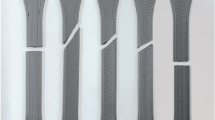Abstract
Three-dimensional printing is the common name given to various techniques used to manufacture different objects. Fused deposition technique is a commonly used additive manufacturing technology in prototyping and production. Fused deposition modelling systems are limited in terms of shape and size of parts. Printing parts with less support material, for parts too large to print in a single operation or for parts with fine details, sectioning and adhesively bonding is the solution for manufacturing. According to adhesion theory, the strength of adhesively bonding between three-dimensional printed parts is affected by surface roughness. Effects of layer thickness and print orientation on adhesion strength of parts manufactured with three-dimensional printing were experimentally studied. As a result of the study, it was found that the edgewise orientation had the highest bonding strength in lower layer thicknesses, while flatwise orientation had the highest bonding strength in higher layer thicknesses.
Similar content being viewed by others
References
L. E. Murr, S. M. Gaytan, F. Medina, E. Martinez, J. L. Martinez, D. H. Hernandez and R. B. Wicker, Characterization of Ti-6Al-4V open cellular foams fabricated by additive manufacturing using electron beam melting, Materials Science and Engineering, A527 (7) (2010) 1861–1868.
B. Vayre, F. Vignat and F. Villeneuve, Designing for Additive Manufacturing, Proceedings of the 45th CIRP Conference on Manufacturing Systems, Athens, 16-18.05.2012, University of Patras, Greece (2012) 632–637.
ASTM F2792, Standard Terminology for Additive Manufacturing Technologies, ASTM International(2012).
S. H. Masood, K. Mau and W. Q. Song, Tensile properties of processed FDM polycarbonate material, Materials Science Forum, 654–656 (2010) 2556–2559.
S. H. Ahn, M. Montero, D. Odell, S. Roundy and P. K. Wright, Anisotropic material properties of fused deposition modeling ABS, Rapid Prototyping Journal, 8 (2002) 248–257.
M. Montero, S. Roundy, D. Odell, S. H. Ahn and P. K. Wright, Material characterization of fused deposition modeling (FDM) ABS by designed experiments, Proceedings of the Rapid Prototyping and Manufacturing Conference, Cincinnati, 15-17.05.2001, Society of Manufacturing Engineers, USA (2001) 1–21.
A. Bellini and S. Güçeri, Mechanical characterization of parts fabricated using fused deposition modeling, Rapid Prototyping Journal, 9 (2003) 252–264.
D. G. Lee, S. Kim and I. Yong-Taek, An experimental study of fatigue strength for adhesively bonded tubular single lap joints, Journal of Adhesion, 35 (1991) 39–53.
M. Shaid and S. A. Hashim, Effect of surface roughness on the strength of cleavage joints, International Journal of Adhesion and Adhesives, 22 (2002) 235–244.
ASTM D3165-07, Standard test method for strength properties of adhesives in shear by tension loading of single-lapjoint laminated assemblies, ASTM International(2014).
V. Kovan, G. Altan, E. S. Topal and H. E. Camurlu, Surface roughness effect on the 3D printed butt joints strength, 8th International Scientific Conference on Tribology, BALTTRIB 2015, Kaunas, Lithuania, 26-27 November(2015).
K. Uehara and M. Sakurai, Bonding strength of adhesives and surface roughness of joined parts, Journal of Materials Processing Technology, 127 (2002) 178–181.
Author information
Authors and Affiliations
Corresponding author
Additional information
Recommended by Associate Editor Hak-Sung Kim
Volkan Kovan received his B.S., M.S. and Ph.D. from the Pamukkale University, Denizli, Turkey. Dr. Kovan is an Associate Professor in the Department of Mechanical Engineering, Akdeniz University, Antalya, Turkey. Prior to joining Akdeniz University in 2010, he was Assistant Professor at Pamukkale University. His research interests are mainly materials and product design.
Gurkan Altan is an Associate Professor in the Department of Mechanical Engineering, Engineering Faculty at Pamukkale University, Denizli, Turkey. Dr. Altan received his B.S. from the Dokuz Eylul University, Izmir, Turkey and M.S. and Ph.D. from the Pamukkale University, Denizli, Turkey. Recently his research interests are joints and 3D Printing.
Eyup Sabri Topal is an Associate Professor in the Department of Mechanical Engineering, Akdeniz University, Antalya, Turkey. Dr. Topal received his B.S., M.S. and Ph.D. from the Erciyes University, Erciyes, Turkey. His main research fields are manufacturing processes.
Rights and permissions
About this article
Cite this article
Kovan, V., Altan, G. & Topal, E.S. Effect of layer thickness and print orientation on strength of 3D printed and adhesively bonded single lap joints. J Mech Sci Technol 31, 2197–2201 (2017). https://doi.org/10.1007/s12206-017-0415-7
Received:
Revised:
Accepted:
Published:
Issue Date:
DOI: https://doi.org/10.1007/s12206-017-0415-7




